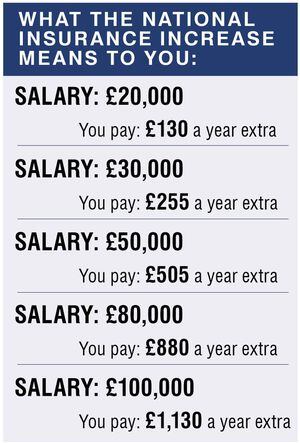National Insurance rise: How much your payments are going up by
The increase in National Insurance contributions will go towards the Government's health and social care reforms, but costs millions of people hundreds of pounds per year

The Government has set out its plans for the biggest catch-up programme in the history of the NHS in England and an overhaul of the social care sector.
- What has been announced?
The Government has pledged to invest £36 billion over the next three years to help the NHS recover from the coronavirus pandemic and reform the adult social care system so people no longer face catastrophic care costs.
From October 2023, nobody will pay more than £86,000 for their social care - regardless of their assets.
The Government will fully cover the cost of care for those with assets under £20,000, and contribute to the cost of care for those with assets of between £20,000 and £100,000.
- Why is this happening?
The NHS waiting list is at an all-time high as the nation recovers from the coronavirus pandemic.
The social care sector has been in need of substantial reform for years, and workforce and sustainability issues have been exacerbated by the recent crisis.

- How will it work?
It will be funded through a UK-wide health and social care levy from April 2022, based on National Insurance contributions paid by working adults.
Between 2022 and 2023 National Insurance rates will rise by 1.25%. From April 2023, the levy will appear as a separate entry on individuals' pay slips. It is at this point that working adults above pension age will chip in.
The Government is also increasing the rate of dividend tax by 1.25% to ensure people who receive income from dividends make the same contribution.
- How much will I have to pay?
The tax will be progressive, meaning those who earn more will pay more.
For example, a basic rate taxpayer earning £24,100 will contribute £3.46 a week, adding up to around £180 over the year.
A higher rate taxpayer earning £67,100 will contribute £7.15 a week, around £715 in total.
Someone on a £50,000 salary, meanwhile, could pay just over £500 more in annual NI contributions, while a worker on £100,000 could see their contributions increase by more than £1,000.
Additional contributions will be shown on payslips.

– Will some workers not pay any extra?
The Government said the progressive nature of the levy meant that 6.2 million people earning less than a threshold of £9,568 in 2021-22 will not pay the levy.
– What about other financial pressures on households?
Many workers have suffered pay cuts, wage freezes and job losses during the coronavirus pandemic.
Rises in living costs are also affecting households, with the Consumer Prices Index (CPI) measure of inflation up by 2% annually in July.
Cash savings rates have been sitting at rock bottom.
Housing costs are also squeezing people’s finances, with the average UK house price hitting a record high of £262,954 in August, according to Halifax.
Phil Kinzett-Evans, partner at UHY Hacker Young, said: “Inflation is hitting everyone, fuel prices are creeping back up to their highest ever, house prices are literally through the roof.”
- How will the NHS benefit?
The money is expected to fund an extra nine million checks, scans and operations, as well as help the NHS focus on innovation.

- What about social care?
Social care will receive £5.3 billion between 2022-23 and 2024-25.
Less than half of this will fund the minimum floor and cap.
Around £500 million will go towards workforce training and skills, while money will also go towards increasing local authority payment rates, integration and quality.
- When will social care get the money?
The social care sector will receive some of the extra money in the next financial year.
But more money will be diverted to the sector after the three-year window as people hit the cap.





